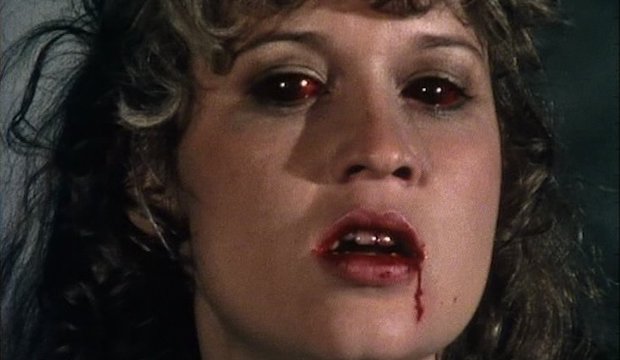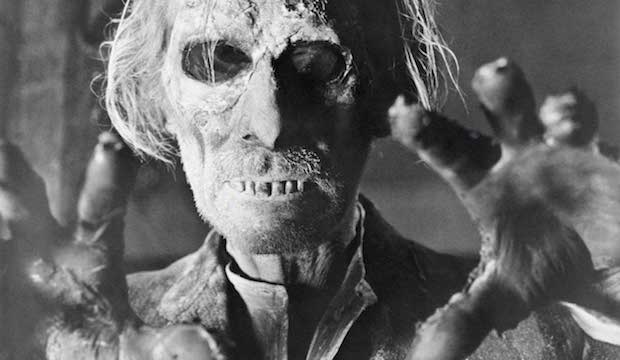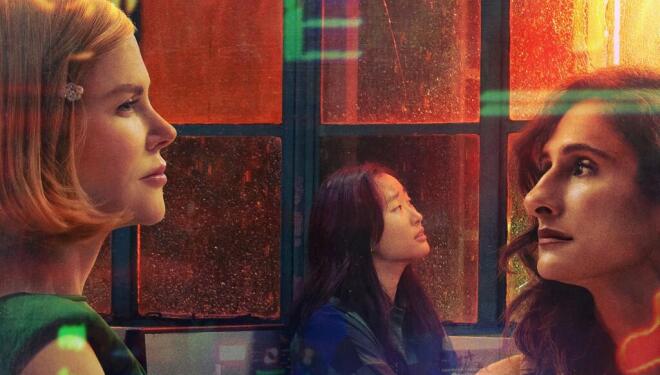The Dead Room Q&A: Mark Gatiss, Anjli Mohindra, Joshua Oakes-Rogers, and Susan Penhaligon
The Dead Room, a new chilling ghost story from Mark Gatiss, is a spooky highlight in the Christmas TV listings. We talk to Gatiss and the cast

Now, writer/director Mark Gatiss revives (again) the traditional BBC Ghost Story for Christmas (originally broadcast in the ’70s) with the terrifying slow burner The Dead Room, airing on Christmas Eve then available on iPlayer for catch up. His story follows Aubrey (Simon Callow), an old, gay radio actor who committed something terrible in 1976. Those buried demons come back to haunt him in the radio studio, the so-called ‘dead room’.
We attended a screening at the BFI Southbank, followed by a Q&A with Gatiss, Anjli Mohindra (Bodyguard, Dark Heart), Susan Penhaligon (Count Dracula, The Uncanny), and Joshua Oakes-Rogers.
You’re obviously reaching back a long way here, Mark. We know about the tradition of the BBC ghost story, there’s the M.R. James ‘rules’. That’s what you’re reaching back to?
Mark Gatiss: Yes, absolutely. Having done an M.R. James, I wanted to do something a bit different. But rather than adapting a story, I thought I’d adapt one of his essays. He wrote several introductions to his stories, in which he basically puts down the rules. But the big thing for me was, by setting it in the modern day, that the ‘haze of distance’ he talks about would be the ‘70s. And I thought, I don’t think I’ve seen a ghost from the ‘70s. That immediately became very exciting for me. The idea of things literally from my own memory becoming the distant past and therefore capable of being spooky.

Legendary ghost story writer M. R. James
You’re also mining a radiant tradition of [radio actor] Valentine Dyall, the ‘Man in Black’, who you took over from [in the BBC Radio 4 show].
Gatiss: Yes, I did it for a while. This is where it started. The producer was always asking me if I’d write one of the stories, and I said I’d do the very last one (this was a way of delaying it). I thought it should be about me as the Man in Black being haunted here in the dead room. I thought, that’s a good title! And I just filed it away.

Valentine Dyall, the 'Man in Black'
Anjli, how was it for you to be incorporated into this tradition? Were you given a reading list or viewing list?
Anjli Mohindra: I have been since, yeah, that I need to crack on with. Ghost stories, for me, are just things I used to watch when I was younger. Apart from Goosebumps, I used to love Goosebumps. Now the idea of reading a ghost story and letting my imagination go off and do its own thing and reveal my dark thoughts… it’s just very exciting.

Anjli Mohindra in The Dead Room
Did you feel the intensity of it? You were filming this in Maida Vale Studios [now since closed down]. When you were performing that scene with Simon [Callow], what’s the atmosphere like in the studio?
Mohindra: It hasn’t been touched or decorated since it was originally built and there’s a real kind of… smell that’s like time. And that silence has a quality to it. That creates an eerie effect.
Did you get that, Susan? Did you get that in your nostrils?
Susan Penhaligon: The smell? Yes. It was a wonderful thing to be part of.
Gatiss: I wrote this part, Joan, based on a lot of people I’ve worked with in radio. I said to Claire, the costume designer, she has to look like she works in a vet’s. She had no lines, but I thought I’ve got to get someone who’s really great. And she ran away with it.
You, of course, have lots of experience in this field, Susan.
Penhaligon: What, being a ghost?
Dracula [1977], The Uncanny with Peter Cushing…
Penhaligon: Yes, that’s true. And also, I’ve done quite a lot of radio – so it was very real to be in there. The whole thing is ghostly. There is this dead quietness…
Gatiss: The ‘dead room’.
Penhaligon: Yes. There’s no sound whatsoever.

Susan Penhaligon in Count Dracula (1977)
Joshua, it was your job to materialise this ghost. You got something precisely characterised, a big story to bring.
Joshua Oakes-Rogers: Yeah, it all comes from what Aubrey says about him. We have this really fleshed out character when he was alive.
Gatiss: Fleshed out…
Oakes-Rogers: He kept it on for that time (laughs)… It was mainly about taking those moments and let the horror speak for itself.
How was that transformation?
Oakes-Rogers: It was fantastic! It was really incredible to watch a master at work. Christine, who did it, spent two hours in the seat. She was a wizard.
Gatiss: It’s very interesting this, the line between fact and fiction. Drowned people who’ve been in the water for a week look ridiculous.
Oakes-Rogers: It’s quite funny actually.
Gatiss: People get very bloated and their eyes pop out, looking like Peter Cushing in Tales from the Crypt. It’s really interesting what [Christine] would bring to the paperiness of the skins.
Oakes-Rogers: She let me make some of my own skin!
Gatiss: There’s all sorts of terrible details. She just told me hair-raising stuff. Lots of times when people drowned, the skin becomes detached from the bone. They call it ‘de-gloving’.

Peter Cushing in Tales from the Crypt (1972)
Were you certain that we were always going to see the face of [the ghost]?
Gatiss: Yes. I think this is a very important thing. M.R. James is absolutely right: holding back in a lovely thing. Lawrence Gordon Clark [creator of the original BBC Ghost Story for Christmas] had such spareness. We don’t see it very much. In James’s stories, he’s fantastically violent, he really goes for it. The ghost is very malevolent, they’re usually vengeful, and someone’s transgressed and has to be punished.
Why [are] sin and guilt such good engines?
Gatiss: For M.R. James, it’s all about pressure. He said friendly ghosts only exist in fairytales and they have no place in the ghost story. I think that’s true, I think you want to have some sort of retribution. It feels very private somehow. It’s very good as well on the subject of actors, a certain kind of very self-assured, grand kind of actor. I don’t know whether you’ve ever encountered anybody like that.
Mohindra: Maybe a few…
Simon [Callow], I’m sure, is the opposite?
Mohindra: He is.

Simon Callow plays the haunted radio actor Aubrey Judd
What was he drawing on?
Mohindra: I’m not sure. Like you say, there are actors like that. I think we’ve all sat in green rooms and been given someone’s version of ‘it all’, as if that’s the way, as if that knowledge imparted to you will give you the Gift.
Penhaligon: There was that feeling of failure about [Aubrey] as well.
Oakes-Rogers: I think it’s quite intrinsic with the storyline. He [committed a crime] for fear of not succeeding.
Gatiss: I drew on Norman Scott and Peter Wyngarde, a shadow that hangs over all of us. And Peter Wyngarde, who’s my first experience of homosexuality – not like that! (laughs) – he was arrested and I said to my mum ‘What’s happened to Jason King [Wyngarde’s character in Department S]?’ And amazingly she said: ‘he’s been caught importuning for men’. She obviously read it in the paper. [Aubrey] was a housewives’ favourite and he couldn’t risk it, and suddenly he’s presented with all his troubles disappearing under the water… He’s been guilty all his life, until he goes back to the studio.
Penhaligon: Also, you have to remember that homosexuality was illegal. This is another thing about actors I’ve worked with, [they] still haven’t got over that. When I first came to the business, they just were quiet about it. You wouldn’t know.
Gatiss: I thought, I don’t wanna make this man a 70-year-old married man with three children. I’m going to write about being gay – I’m gay – and I don’t think I’ve seen that, and thought it was an interesting place to push it. Simon and I had a lot of very interesting talks. He was exactly of that sort of generation.

Peter Wyngarde was charged with 'gross indecency' in 1975
This may be why M.R. James’s rule about when to set a ghost story is so powerful. It says something about our relationship with men and history, what you can use.
Gatiss: Your automatic ‘reaching back’ is to headless horseman or Victorian spooks. But there is a real power if it’s just out of reach, in the way that 1976 feels. It’s there, but it’s not there.
What are your thoughts about that, Josh, who clearly wasn’t around in 1976?
Oakes-Rogers: It was a great year for me (laughs). All the music... that’s always been there anyway, with my mum’s vast record collection. But mainly I was excited by the fact I got to wear flares. It’s within memory for some people, and it’s a kind of iconised version for my generation. There’s thousands of Spotify playlists from the ’70s and ’80s, and it’s become an image. That whole era is an image. It does give you enough leeway to go, yeah, well maybe there’s someone spooky with this crazy hair…
Gatiss: I think [The Dead Room is] a love story. I was in an interview this afternoon with someone who’d seen it at the cinema, [saying] it was like Death in Venice by Roald Dahl. I said, ‘I’ll take that!’
Josh, before you took the job on, were you familiar with many of your other fellow TV ghosts?
Oakes-Rogers: I don’t know! The main ghosts in my life… [in] Goosebumps, there was one about this really terrifying zombie cat and I didn’t sleep for weeks. But playing ghosts, I didn’t really want to play the style too much – I wanted to play a person. The main thing was just finding the information I could about who this guy was, what his relationship with Aubrey was. [Paul] was a real optimist, he didn’t understand what was going on, he didn’t understand why they couldn’t be together. It didn’t make sense to him. I think that’s the story I wanted to tell.

From the Goosebumps episode The Cry of the Cat (1998)
Have you ever seen a ghost?
Oakes-Rogers: No…
Penhaligon: We had this on the first rehearsal. Mark asked us all if we believed in ghosts, and if we had any ghost stories.
Oakes-Rogers: My mum had one. She said she woke up, and there was this woman in the mirror.
Gatiss: It’s her (laughs).
Penhaligon: Simon said he didn’t believe in ghosts.
Mohindra: I’m ‘aghostic’. If anyone knows any…
[to Mark] Have you ever felt a cold hand on your shoulder?
Gatiss: Frequently (laughs). I did the same thing in Crooked House ten years ago – ‘Do you believe in ghosts?’ ‘No, but I’m afraid of them’. No, I don’t believe in the continuation of the spirit or anything like that, but I think there’s something in it. There’s thousands of years’ worth of ghost stories in every culture, and it must mean something. And people do still see ghosts, especially after a bereavement. Maybe it’s in people’s heads, or maybe it’s something to do with quantum physics if you wanna go there – it all makes sense in a multiverse. But in real life, they rarely seem to be vengeful. They seem to be sort of memories.
What references or what decisions [did you make] in the set up [for The Dead Room]?
Gatiss: I wanted it to be very ’70s. The font even was carefully sourced to be a Play for Today type. I like the way that telly in those days used to be very experimental. Because [The Dead Room] is about sound the score is not music, it’s just sounds. I loved that too – about trying to do something that wasn’t over-larding it with music, which I particularly loathe in drama these days. When you’re told what to think… Space and silence and spareness can be very, very eloquent.
Which existing ghost story would you love to adapt?
Gatiss: All the ones that Aubrey mentions. Well, the outstanding M.R. James’s Count Magnus is a great story. It’s never been done, except for the bit with the padlocks falling off the coffin which is in Brides of Dracula (1960) – they just nicked it. It eluded Lawrence Gordon Clark, and it eludes people still. Maybe it’s not meant to be.

Brides of Dracula (1960)
What would you think M.R. James [would’ve made] of The Dead Room? There’s obviously lots of debate about his own sexuality…
Gatiss: I think he’d think it was the best thing ever (laughs). I interviewed a wonderful man called Canon Adrian Carey, who knew him and used to visit him when he was dying. I was sort of pussyfooting around: ‘Do you think he found the company of young men stimulating?’. And he said, ‘I think he’s what we would now call a “non-practising homosexual”’. [James] was a very reticent man. He’s also a very funny, very playful man, a huge circle of friends. I think he’d have found its playfulness quite pleasing. A pleasing terror.
We don’t see a lot of M.R. James on the big screen (and his contemporaries), but a lot on the small screen. Why do you think it lends itself to television so much better than it does to film?
Gatiss: It’s mostly because they’re short stories, and that’s what works. A movie-length ghost story is a different beast – it’s The Haunting or The Shining, they’re much bigger things. [James’s] stories, which are meant to be read on Christmas Eve, are short and pithy and lend themselves nicely to short adaptations.

'A movie-length ghost story is a different beast - it's The Haunting or The Shining'
Did you ever wake up with a start in the night after watching horror movies?
Mohindra: That’s why I had to stop!
Penhaligon: I think I have actually. I think I might’ve had a few drinks… I was going through a very bad time, and I remember waking up and there were black shapes around me. They were like creatures, and I believe they’d been written about and there was a name for those creatures – I can’t remember what it is…
Gatiss: You were pissed (laughs).
Penhaligon: Yes! But it was very real. Whether that was my imagination or my state of mind… They were very bat-like, very Dracula actually…
The Dead Room airs on BBC Four at 9pm on Christmas Eve






